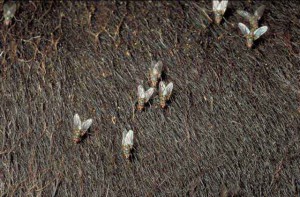 One of the things beef producers dread most about the coming warm weather is the advent of troublesome horn flies.
One of the things beef producers dread most about the coming warm weather is the advent of troublesome horn flies.
These insects are annoying, to be sure. But, they are more than just pests, they are really “obligate parasites,” who must stay with –and live off of- their host in order to survive. They feed on cattle by cutting through the skin and sucking blood. This is not only painful and distressing for the animal, but also has a direct impact on body condition, and consequently, on the producer’s bottom line.
“Making blood is an expensive process,” according to Scott Boutilier, vice president of sales and marketing for Central Life Sciences (CLS) professional businesses. “All that blood is lost body mass, weight, meat and muscle that could have been going on someone’s plate.”
As a result, Boutilier says, an estimated $800 million are lost each year to horn flies.
The gold standard in controlling these pests is S-Methoprene, the generic name for Altosid® IGR, which is registered to a subsidiary of CLS.
The product, originally developed in the late 1960’s for mosquito control, was registered by the EPA in 1975 as a cattle feed-through product. Incorporated into cattle feed, Altosid passes through the animals without affecting them, remaining in manure to control horn flies. It does this by mimicking a juvenile fly hormone that inhibits fly larvae from maturing.
“Methoprene by nature is very similar to juvenile insect hormones,” said Boutilier, who studied entomology, chemistry and insect physiology in undergraduate and graduate school. “It’s very complex chemically but environmentally benign. It breaks out into very simple compounds, so it doesn’t have negative effects on the environment.”
In fact, the EPA has determined that the use of methoprene is exempt from tolerance. And, insects have not developed a resistance to Altosid, unlike many other insect control products that kill the adult.
“At the same time,” he explained, “the product is sensitive to sunlight, so delivery and formulation is critical to its performance. And, you have to make sure you deliver the correct amount to achieve the right effect.”
As a result, CLS has created a variety of formulations, all very specific to their intended uses. In the cattle market, for instance, they created a formula that will pass through and remain in manure. The dosage is low enough that it affects horn flies, but doesn’t inhibit dung beetles’ ability to break down manure. The dosage is typically about 1.1 mg per hundredweight of animal, per day.
Boutilier described the work Purina has done on consumption and intake management as “elegant”. It’s a method they use in their Wind and Rain® Fly Control Mineral tubs, in which Altosid is incorporated. Through taste and physical properties, the method actually controls how much the animal consumes, thereby keeping the nutrients at appropriate levels for the desired effect.
“They’ve made the product attractive, so that cattle will eat it, but only eat so much,” he explained. “Then after a while, they will come back for more. It’s an amazing level of sophistication tht has evolved with Purina’s IM Tech (Intake Modifying Technology®) program.” Boutilier says such methods of incorporating Altosid with preexisting feeding programs constitute a very cost-efficient way of controlling horn flies.
“If you are going to feed an animal anyway, you have no additional labor cost to deliver the horn fly control with feed,” he pointed out. “Plus, this method is so much easier than an ear tag or back rubber. And, every dollar you spend yields 6-10 dollars in increased weight gain and faster weight gain, so it is a high value solution for cattle producers.”
Boutilier said producers should start administering the product about a month before horn flies start maturing until about 30 days after the first hard frost. That way they can virtually eliminate the horn fly season. He stressed that administering Altosid 30 days after the first frost is needed to make sure the insect doesn’t go into pupae.
“Most cattle producers who start on the program stay on it, because it is effective and delivers a good return,” he concluded. “Customer satisfaction is very high.”
For more information about options for controlling horn flies through mineral supplements, contact us.
Article: Purina Mills Cattle
